The Arts on Stamps of the World — July 6
An Arts Fuse regular feature: the arts on stamps of the world.
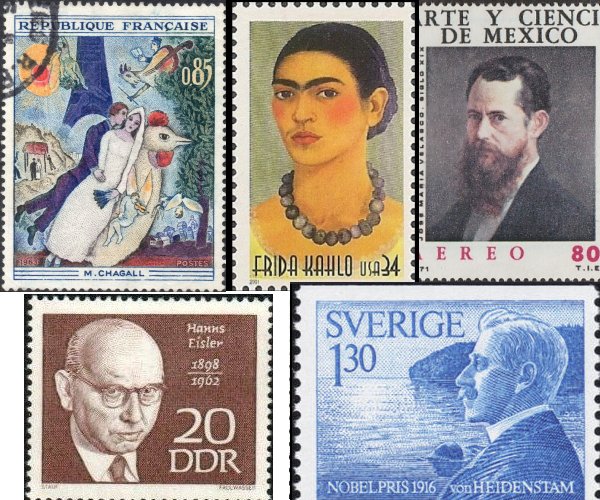
By Doug Briscoe
Two painters top our birthday list for this July 6, Marc Chagall and Frida Kahlo. A third, Kahlo’s countryman José María Velasco, also appears in today’s lineup, and we have a chess master from Germany, a Nobel Prize winning writer from Sweden, a French can-can dancer (!), a Finnish poet, an Austrian composer, a Dutch architect, Australian actor Geoffrey Rush, and America’s Sylvester Stallone and Bill Haley (of the Comets).
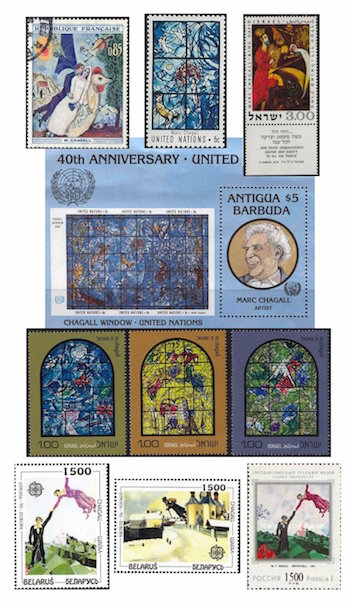
The first postage stamp showing the work of Marc Chagall (6 July [O.S. 24 June] 1887 – 28 March 1985) was issued by France in 1963, so we lead with that: The Married Couple of the Eiffel Tower (1938-9). The following year, 1964, Chagall created a large stained glass memorial called Peace in honor of Dag Hammarskjöld for the UN. It was reproduced in full on a postal minisheet in 1967 along with a detail, The Kiss of Peace, on an individual stamp. For the 40th anniversary of the UN in 1985, Antigua issued another minisheet copying the UN issue of Peace along with a portrait of the artist. Israel has twice released Chagall art works on stamps: 1969’s King David (1951) and a full set of twelve stamps of his stained glass windows depicting the twelve tribes of Israel; these were made for the synagogue of the Hadassah Medical Center in 1960, and the stamps appeared in 1973. I show just three from the set. Belarus has not been philatelically remiss in honoring its native son and, appropriately, in 1973 they chose not only Chagall’s Promenade (1918) but also his Man Over Vitebsk (1914), near which city Chagall was born. Promenade was also selected for a Russian issue of 1997.
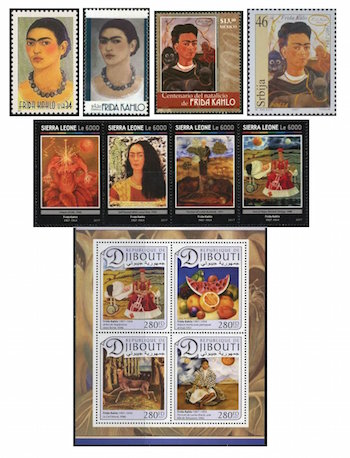
Mexican artist Frida Kahlo (July 6, 1907 – July 13, 1954) is also well represented on stamps of the world, with even the United States honoring her in 2001. (I offer a reminder that the U.S. rarely honors non-Americans on its stamps, and Communists? Forget it! Naturally the selection of Kahlo caused a bit of a stir in certain circles.) In the same year Mexico issued a stamp using the same Self Portrait with Necklace (1933). For her centenary, both Mexico and Serbia chose Kahlo’s 1945 Self Portrait with Small Monkey. I can’t resist also presenting two lovely groups of Kahlo stamps, the first from Sierra Leone, consisting of Flower of Life (or Flame Flower) (1943), Self-Portrait with Loose Hair (1947), Portrait of Luther Burbank (1931), and Tree of Hope, Remain Strong (1946). This last painting, a reflection of Kahlo’s lifelong struggles with ill health (always problematic, with polio and a disastrous streetcar injury in her youth), also shows up as the first in a block of four from Djibouti along with Still Life with Parrot and Fruit (1951), The Wounded Deer (1946), again a portrayal of her physical suffering, and finally, Portrait of Lucha Maria, a Girl from Tehuacan (1942). For years Kahlo’s work was overshadowed by that of her husband Diego Rivera. Only decades after her death was the quality of her art given the recognition it deserves.
Another Mexican painter, albeit one of a much earlier generation, was José María Velasco (1840 – 26 August 1912). Unlike Kahlo he was celebrated internationally during his lifetime, earning medals in Philadelphia and Paris as well as in Mexico. And yet despite this reputation I was able to find only one stamp for him, showing his Self-portrait of 1894. His masterpiece is considered to be El valle de México, of which he made seven versions. Velasco was also a scientist, a student of anatomy, zoology, botany, and geology, among other disciplines. He discovered a new species of salamander that was named Ambystoma velasci in his honor.
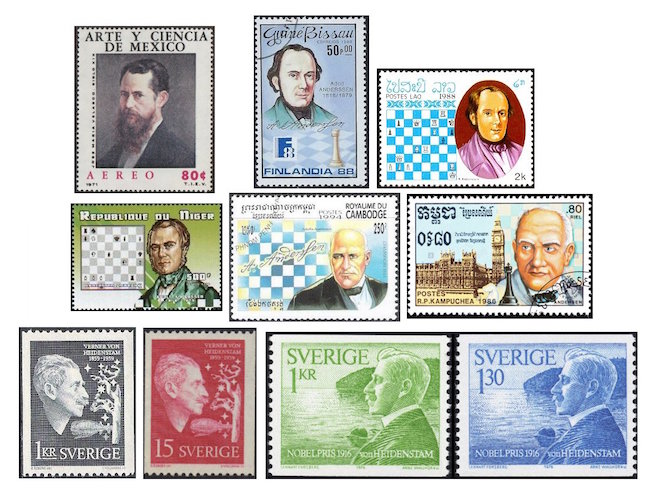
At the risk of repeating myself, I’ve taken to including chess masters here on The Arts on Stamps of the World because of the beauty of some of their creations. German player Adolf Anderssen (July 6, 1818 – March 13, 1879) was held by some to be the greatest player in the world until his defeat by the American Paul Morphy. But in 1851 he played what is known as “The Immortal Game”, which Garry Kasparov has called one of the “crown jewels” of chess. Anderssen sacrificed a bishop, both rooks, and his queen to inflict a mate on his opponent Lionel Kieseritzky, who had lost only three pawns. This was at the famous London International Tournament organized by Howard Staunton. Anderssen made his living as a math teacher.
Swedish poet and novelist Verner von Heidenstam (6 July 1859 – 20 May 1940) won the Nobel Prize in Literature in 1916. He left school, where he was studying painting, because of a delicate constitution and traveled the world, producing not only a book of travel but also a volume of poems that evoked the orient. The next year, 1889, saw the first of his novels; his best known fiction work, though, was The Charles Men (1897-98), an historical cycle about Swedish King Charles XII. It was for this work in particular that Heidenstam was awarded the Nobel Prize.
Well, it’s time for another novelty here on The Arts on Stamps of the World: our first can-can dancer. Louise Weber (13 July 1866 – 30 January 1929) danced at the Moulin Rouge under the stage name of La Goulue (the glutton), because she used to toss off customers’ drinks while dancing around their tables. She attracted the attention of Toulouse-Lautrec, who painted her a number of times. Both of the stamps we have for La Goulue owe their existence to the painter. The one from the Kathiri State of Seiyun in South Arabia features Toulouse-Lautrec’s La Goulue arriving at the Moulin Rouge (1892). Weber frittered away her considerable earnings and declined into depression and alcoholism.
The important Finnish poet and journalist Eino Leino (6 July 1878 – 10 January 1926) published his first poem when he was 12 and went on to produce seventy volumes of poems and stories. He was not only one of the pioneers of Finnish nationalism in literature, but even coined the term “national neoromantism”, covering all the arts, to reflect the new movement. The music of Sibelius, the paintings of Gallen-Kallela, and the architecture of Eliel Saarinen all fell under this umbrella. Leino’s texts were set as songs and choruses by composers such as Toivo Kuula (whose birthday is tomorrow!) and Leevi Madetoja. I could, however, find only one Sibelius setting: the brief choral cantata “Hymn to the Earth”, Op. 95, of 1919. Quite recently, pianist and composer Olli Mustonen set Leino’s words in his Symphony of Chance for baritone and orchestra (2012). Leino was also the first to translate Dante’s Divine Comedy into Finnish. His great-grandson Jei Leino succeed Jani Karsson as the host of The Tonight Show.
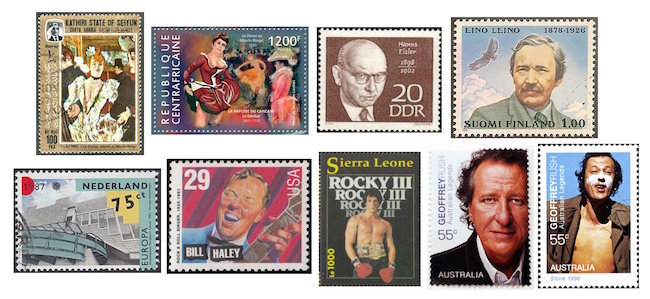
Austrian composer Hanns Eisler (1898-1962) was born on July 6 and best known for his collaborative work with Berthold Brecht. His father was Jewish, and Eisler and his two siblings were both ardent Communists (though his sister later recanted with a will). He was wounded several times in World War I and on his return home studied for four years with Schoenberg, then moved to Berlin in 1925. With Brecht Eisler wrote the “Solidarity Song”, which came to be sung by ardent leftists throughout Europe, and “Ballad of Paragraph 218”, the first song to protest anti-abortion laws. In 1933, both men fled the country, Eisler becoming decidedly peripatetic: in the next years, he worked in Prague, Vienna, Paris, London, Moscow, Spain, Mexico, Denmark, and the US, where he finally settled in 1938 with a permanent visa. He reunited with Brecht in Los Angeles in 1942. Two of Eisler’s eight Hollywood film scores were nominated for Oscars (Hangmen Also Die! in 1944 and None but the Lonely Heart in 1945), but with the coming of the Cold War he was one of the first artists to be blacklisted. Among his accusers was his formerly Communist sister! He was deported in 1948 despite help from Charlie Chaplin, Igor Stravinsky, Aaron Copland, and Leonard Bernstein and international support from Einstein, Picasso, Thomas Mann, Jean Cocteau (whose birthday was yesterday), and Matisse. Woody Guthrie wrote a protest song, “Eisler On the Go”, in response. Eisler went to East Germany, where he wrote the national anthem of the DDR and resumed working with Brecht, who died in 1956, after which Eisler’s mood deteriorated and his health declined. Although he never rejected Communism, he did welcome the demise of Stalinism and supported the East German dissident singer-songwriter Wolf Biermann. His compositions include forty film scores, a Kleine Sinfonie (Little Symphony; 1932), and a number of chamber and piano pieces, besides his many vocal works of various kinds.
Bill Haley (July 6, 1925 – February 9, 1981) and the Comets had a hit with 1953’s “Rock Around the Clock” and another with “Shake, Rattle and Roll” the next year. “Rock Around the Clock” achieved even greater fame after it was used in the 1955 high school drama Blackboard Jungle with Glenn Ford, and it went on to become the first record ever to exceed one million sales in both Great Britain and Germany.
Dutch architect Herman Hertzberger (born 6 July 1932) is perhaps best known for his Montessori School in Delft (1966–70) and Willemspark School in Amsterdam (1983), the latter being seen on the Dutch stamp of 1987. Hertzberger has also written a number of books on architecture.
And happy birthday to actors Sylvester Stallone (born 1946), seen on a Rocky stamp from Sierra Leone, and Geoffrey Rush (born 1951), saluted with a pair of Australian stamps, one of which recalls his performance as David Helfgott in Shine (1996).
A graduate of the University of Massachusetts with a B.A. in English, Doug Briscoe worked in Boston classical music radio, at WCRB, WGBH, and WBUR, for about 25 years, beginning in 1977. He has the curious distinction of having succeeded Robert J. Lurtsema twice, first as host of WGBH’s weekday morning classical music program in 1993, then as host of the weekend program when Robert J.’s health failed in 2000. Doug also wrote liner notes for several of the late Gunther Schuller’s GM Recordings releases as well as program notes for the Boston Classical Orchestra. For the past few years he’s been posting a Facebook “blog” of classical music on stamps of the world, which has now been expanded to encompass all the arts for The Arts Fuse.
